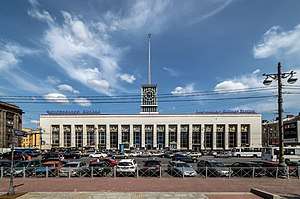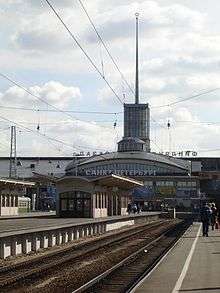Finland Station
St Petersburg–Finlyandsky (Russian: Станция Санкт-Петербург-Финля́ндский Stantsiya Sankt-Peterburg-Finlyandskiy) (IATA: FVS), is a railway station in St. Petersburg, Russia, handling transport to westerly destinations including Helsinki and Vyborg.
St.Petersburg–Finlyandsky | |||||||||||
|---|---|---|---|---|---|---|---|---|---|---|---|
 St.Petersburg-Finlyandsky main building | |||||||||||
| Location | 5 Lenin Square, Saint Petersburg, Russia | ||||||||||
| Coordinates | 59°57′20″N 30°21′24″E | ||||||||||
| Platforms | 5 island platforms | ||||||||||
| Tracks | 10 | ||||||||||
| Connections | Saint Petersburg Metro station: | ||||||||||
| Construction | |||||||||||
| Structure type | At-grade | ||||||||||
| Other information | |||||||||||
| Station code | 03820 | ||||||||||
| Fare zone | 0 | ||||||||||
| History | |||||||||||
| Opened | 1870 | ||||||||||
| Rebuilt | 1960 | ||||||||||
| Electrified | 1952 | ||||||||||
| Traffic | |||||||||||
| Passengers | 12 million p.a. | ||||||||||
| Services | |||||||||||
| |||||||||||

The station is most famous for having been the location where Vladimir Lenin returned to Russia from exile in Switzerland on 16 April 1917 (N.S.), ahead of the October Revolution.
History
Finland Station was built by Finnish State Railways as the eastern terminus of the Riihimäki–Saint Petersburg railway. It was designed by Swedish architects and opened in 1870. The station formerly contained a special pavilion for Russian royalty.
Russian Revolution
The station was owned and operated by Finnish railways until early 1918, when the last train, carrying station personnel and equipment, as well as some of the last Finns escaping revolutionary Russia, left for Finland. Later, ownership of the station was exchanged for Russian property in Finland, including the Alexander Theatre in Helsinki.
The station is famously known for the arrival of Vladimir Lenin by train from Switzerland on 3 April 1917 (O.S.). The event is commemorated by the Soviet statue of Lenin dominating the square in front of the station. This event is also referred to in the title of Edmund Wilson's book To the Finland Station (1940), a well-known study of revolutionary thought.
After the turmoil of the July Days, when workers and soldiers in the capital clashed with government troops, Lenin had to flee to Finland for safety, to avoid arrest. Lenin secretly returned from Finland disguised as a railway worker and protected by Eino Rahja and Alexander Shotman on 9 August 1917. Both times Lenin crossed the Russian–Finnish border on the engine #293 driven by Finnish engineer Hugo Jalava (Гуго Эрикович Ялава). The steam locomotive was donated by Finland to the Soviet Union in 1957, and is now installed as a permanent exhibit at one of the platforms on the station.
Siege of Leningrad
During the Siege of Leningrad in 1941–43, the Finland Station was the only Leningrad rail terminus that remained in use. The railway would connect Leningrad with a station near the western shore of Lake Ladoga, at which supplies from the non-occupied parts of the Soviet Union would arrive from across the lake, by boat or over the lake ice, via the so-called Road of Life.
Reconstruction
In the 1950s, the old station building was demolished and replaced with a new one, inaugurated in 1960. The turreted building is decorated with sculptures glorifying the October Revolution and incorporates a portico preserved from the original 1870 edifice.
Damage to Lenin's statue
Before dawn on Wednesday 1 April 2009 a bomb exploded in the statue of Lenin, creating an 80–100 cm hole in the back of the statue.[1]
In popular culture
"West End Girls", a 1984 song by The Pet Shop Boys, contains the lyric "From Lake Geneva to the Finland Station". The song's co-writer, Neil Tennant, has a well-known interest and background in history (subject of his degree), particularly that of Russia. This line refers to the train route taken by Vladimir Lenin when he was smuggled by the Germans to Russia during the First World War, a pivotal event in the Russian Revolution.[2] Edmund Wilson's book To the Finland Station, which Tennant most likely had read, may have also influenced this song's line.
Trains and destinations
Trains from Helsinki arrive at the station, except for a transit train to Moscow through Ladozhsky railway station. The station is also a part of high-speed rail line between Saint Petersburg and Helsinki (see Karelian Trains).
The main entrance to the metro station Ploshchad Lenina is in the main building of Finland Station.
Long distance
| Train number | Train name | Destination | Operated by | Notes |
|---|---|---|---|---|
| 033/034 | Repin (rus: Репин) | Terminated on December 13, 2010 | ||
| 035/036 | Sibelius (fin: Sibelius) | Terminated on December 13, 2010 |
High-speed rail
| Train number | Train name | Destination | Operated by |
|---|---|---|---|
| No. 781/782, 783/784, 785/786, 787/788 | Allegro (fin: Allegro rus: Аллегро) |
Suburban destinations
Suburban commuter trains (elektrichka) connect Finlyandsky station with the towns of Sestroretsk, Zelenogorsk, Primorsk, Vyborg and Priozersk.
Route maps
Local lines and fare zones from Finlyandsky Rail Terminal | |||||||||||||||||||||||||||||||||||||||||||||||||||||||||||||||||||||||||||||||||||||||||||||||||||||||||||||||||||||||||||||||||||||||||||||||||||||||||||||||||||||||||||||||||||||||||||||||||||||||||||||||||||||||||||||||||||||||||||||||||||||||||||||||||||||||||||||||||||||||||||||||||||||||||||||||||||||||||||||||||||||||||||||||||||||||||||||||||||||||||||||||||||||||||||||||||||||||||||||||||||||||||||||||||||||||||||||||||||||||||||||||||||||||||||||||||||||||||||||||||||||||||||||||||||||||||||||||||||||||||||||||||||||||||||||||||||||||||||||||||||||||||||||||||||||||||||||||||||||||||||||||||||||||||||||||||||||||||||||||||||||||||||||||||||||||||||||||||||||||||
|---|---|---|---|---|---|---|---|---|---|---|---|---|---|---|---|---|---|---|---|---|---|---|---|---|---|---|---|---|---|---|---|---|---|---|---|---|---|---|---|---|---|---|---|---|---|---|---|---|---|---|---|---|---|---|---|---|---|---|---|---|---|---|---|---|---|---|---|---|---|---|---|---|---|---|---|---|---|---|---|---|---|---|---|---|---|---|---|---|---|---|---|---|---|---|---|---|---|---|---|---|---|---|---|---|---|---|---|---|---|---|---|---|---|---|---|---|---|---|---|---|---|---|---|---|---|---|---|---|---|---|---|---|---|---|---|---|---|---|---|---|---|---|---|---|---|---|---|---|---|---|---|---|---|---|---|---|---|---|---|---|---|---|---|---|---|---|---|---|---|---|---|---|---|---|---|---|---|---|---|---|---|---|---|---|---|---|---|---|---|---|---|---|---|---|---|---|---|---|---|---|---|---|---|---|---|---|---|---|---|---|---|---|---|---|---|---|---|---|---|---|---|---|---|---|---|---|---|---|---|---|---|---|---|---|---|---|---|---|---|---|---|---|---|---|---|---|---|---|---|---|---|---|---|---|---|---|---|---|---|---|---|---|---|---|---|---|---|---|---|---|---|---|---|---|---|---|---|---|---|---|---|---|---|---|---|---|---|---|---|---|---|---|---|---|---|---|---|---|---|---|---|---|---|---|---|---|---|---|---|---|---|---|---|---|---|---|---|---|---|---|---|---|---|---|---|---|---|---|---|---|---|---|---|---|---|---|---|---|---|---|---|---|---|---|---|---|---|---|---|---|---|---|---|---|---|---|---|---|---|---|---|---|---|---|---|---|---|---|---|---|---|---|---|---|---|---|---|---|---|---|---|---|---|---|---|---|---|---|---|---|---|---|---|---|---|---|---|---|---|---|---|---|---|---|---|---|---|---|---|---|---|---|---|---|---|---|---|---|---|---|---|---|---|---|---|---|---|---|---|---|---|---|---|---|---|---|---|---|---|---|---|---|---|---|---|---|---|---|---|---|---|---|---|---|---|---|---|---|---|---|---|---|---|---|---|---|---|---|---|---|---|---|---|---|---|---|---|---|---|---|---|---|---|---|---|---|---|---|---|---|---|---|---|---|---|---|---|---|---|---|---|---|---|---|---|---|---|---|---|---|---|---|---|---|---|---|---|---|---|---|---|---|---|---|---|---|---|---|---|---|---|---|---|---|---|---|---|---|---|---|---|---|---|---|---|---|---|---|---|---|---|---|---|---|---|---|---|---|---|---|---|---|---|---|---|---|---|---|---|---|---|---|---|---|---|---|---|---|---|---|---|---|---|---|---|---|---|---|---|---|---|---|---|---|---|---|---|---|---|---|---|---|---|---|---|---|---|---|---|---|---|---|---|---|---|---|---|---|---|---|---|---|---|---|---|---|---|---|---|---|---|---|---|---|---|---|---|---|---|---|---|---|---|---|---|---|---|---|---|---|---|---|---|---|---|---|---|---|---|---|---|---|---|---|---|---|---|---|---|---|---|---|---|---|---|---|---|---|---|---|---|
| |||||||||||||||||||||||||||||||||||||||||||||||||||||||||||||||||||||||||||||||||||||||||||||||||||||||||||||||||||||||||||||||||||||||||||||||||||||||||||||||||||||||||||||||||||||||||||||||||||||||||||||||||||||||||||||||||||||||||||||||||||||||||||||||||||||||||||||||||||||||||||||||||||||||||||||||||||||||||||||||||||||||||||||||||||||||||||||||||||||||||||||||||||||||||||||||||||||||||||||||||||||||||||||||||||||||||||||||||||||||||||||||||||||||||||||||||||||||||||||||||||||||||||||||||||||||||||||||||||||||||||||||||||||||||||||||||||||||||||||||||||||||||||||||||||||||||||||||||||||||||||||||||||||||||||||||||||||||||||||||||||||||||||||||||||||||||||||||||||||||||
| |||||||||||||||||||||||||||||||||||||||||||||||||||||||||||||||||||||||||||||||||||||||||||||||||||||||||||||||||||||||||||||||||||||||||||||||||||||||||||||||||||||||||||||||||||||||||||||||||||||||||||||||||||||||||||||||||||||||||||||||||||||||||||||||||||||||||||||||||||||||||||||||||||||||||||||||||||||||||||||||||||||||||||||||||||||||||||||||||||||||||||||||||||||||||||||||||||||||||||||||||||||||||||||||||||||||||||||||||||||||||||||||||||||||||||||||||||||||||||||||||||||||||||||||||||||||||||||||||||||||||||||||||||||||||||||||||||||||||||||||||||||||||||||||||||||||||||||||||||||||||||||||||||||||||||||||||||||||||||||||||||||||||||||||||||||||||||||||||||||||||||||||||||||||||||||||||||||||||||||||||||||||||||||||||||||||||||||||||||||||||||||||||||||||||||||||||||||||||||||||||||||||||||||||||||||||||||||||||||||||||||||||||||||||||||||||||||||||||||||||||||||||||||||||||||||||||||||||||||||||||||||||||||||||||||||||||||||||||||||||||||||||||||||||||||||||||||||||||||||||
See also
- Riihimäki–Saint Petersburg Railway
- Saint Petersburg–Hiitola railway
- Emperor railway station, Pushkin town
References
- "Europe | Bomb blows hole in Lenin statue". BBC News. 2009-04-01. Retrieved 2012-08-20.
- "West End Girls lyrics analysis". Wayne Studer, Ph.D. Retrieved 2015-11-18.
External links
![]()